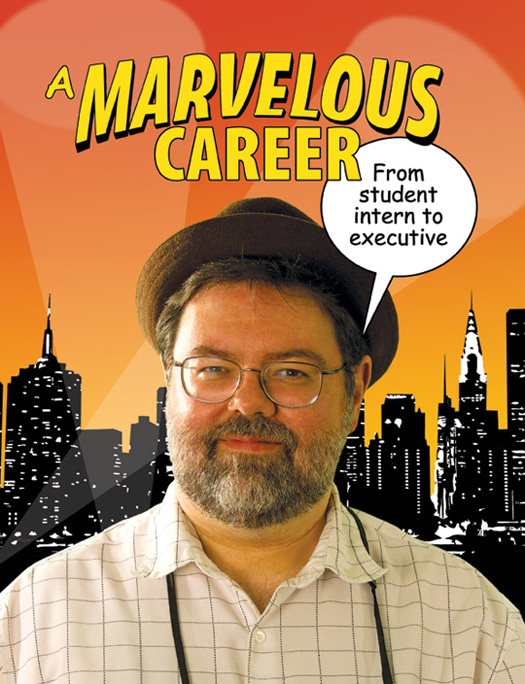
ALUMNI | During his first week in the UD illustration program, Tom Brevoort learned that all art students would be required to do an internship in their senior year. Among the examples of places where previous students had interned was Marvel Comics.
"So I thought, 'OK, that's what I will do in three years,'" Brevoort says.
Not only did he go on to land an internship at Marvel, he made a career there. He's steadily moved up the ranks over the past 23 years to his current role as senior vice president and executive editor, publishing comic books about Iron Man, Captain America, the X-Men and other time-honored favorites.
From Marvel's offices in New York City, Brevoort is responsible for hiring creative teams, overseeing plotlines, suggesting stories and even changing characters' costumes. While his focus is on publishing, he consults on Hollywood adaptations such as this summer's blockbuster The Avengers.
Brevoort's interest in comic books started when he was about 6, when he remembers going to a convenience store with his father and eyeing the comic rack. His dad asked him if he wanted one, and he answered yes.
"I started buying them more regularly after that—and more and more and more as the years went by," he says.
His early favorites were not Marvel characters at all, but rather DC Comics' Superman and The Flash. In those days, he found Marvel characters to be above his age level and did not start reading about the Fantastic Four, Spiderman and Daredevil until he was older.
By the time he was a teenager, Brevoort moved from New York to Delaware with his family and attended Glasgow High School. Having always enjoyed drawing, he became an illustration major at UD and also dabbled in computer science.
His familiarity with computers served him well once he got to Marvel. The company had only one computer in 1989, and despite being a college intern, he knew how to use it as well as anyone there. While his internship involved all sorts of small tasks like making photocopies, looking up references and sending rejection letters for cold submissions, he would typeset using the computer when needed.
"It wasn't that big a part of our business at the time—but just knowing how to use our big old Apple II was a valuable skill that few others had," he says.
How times have changed. Nearly everything is done differently now than 20 years ago, Brevoort says. Artists may still draw by hand, but they are more likely to use an electronic stylus and tablet than a mechanical pencil and paper. Comics are offered in online versions, and Marvel recently launched an "Infinite Comics" format for iPads that provides graphic transitions between panels under the control of the reader, while still keeping true to comics' text-and-pictures appeal.
"This is going to have a big impact on the way we tell stories," Brevoort says. "We expect it to be a big part of our lives in the future as we transition more and more to a digital model."
Yet no matter what the medium, Brevoort says it's the stories and characters that have resonated with the public for decades with conflicts and situations that reflect themes in the real world. At their bases, he said, they're very relatable, understandable characters.
Which is his favorite?
"I think The Thing," Brevoort says. "He's a quintessentially great Marvel character in that at his core he's the sort of the reverse of the typical." Unlike many superheroes enhanced by their special powers, The Thing got hit by cosmic rays and turned into a big, monstrously hulking lump, he explains. Everything he once took for granted, he couldn't do anymore, like dialing the phone or opening a door. The Thing has a certain amount of tragedy, Brevoort says, yet he still does good with his powers and masks his pain through humor.
Perhaps it's the characters' sympathetic sides that in particular relate to youth. Brevoort says he regularly hears anecdotes not only about kids who became enthusiastic about reading through comic books, but also about those who found inspiration for their own struggles. A mother stopped him at a conference, for example, to share how motivating comics were to her son with Asperger syndrome.
"People of all sorts tend to find something in the Marvel books that speaks to them in a very direct and personal way," he says.
As for students trying to find their ways through college, Brevoort's advice is to look beyond financial success and find the things that they really like to do. His summer internship at Marvel was unpaid, after all, and he worked at a fast food restaurant on the weekends to help cover expenses.
"Find something that you like that genuinely interests you, that makes you want to get up in the morning, and do stuff that you would maybe do anyway if they didn't pay you for it," he says. "Then make that the backbone of your life and your existence."
Article by Teresa Messmore





